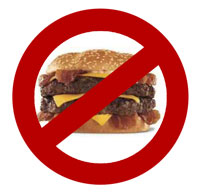The average person, according to the experts, makes 200 food-related choices a day. Actually, make that 201 choices. Courtesy of a new campaign by a leading restaurant chain, diners who are used to choices that make their meals bigger can now actually choose to order portions that are significantly smaller.
This spring, T.G.I. Friday’s announced what it called an “unprecedented move in the casual dining industry” when the restaurant chain began offering smaller portions at lower prices for select dishes. Called the “right portion, right price” menu, T.G.I. Friday’s added six new smaller entrees to its line-up — Asian-glazed chicken with field greens, cedar-seared salmon with pasta, to name two — and also began offering smaller portions for four of its long-standing menu favorites like shrimp Key West and baby back ribs. These “right portion” menu options offer approximately one-third less food at one-third less cost than the same regular-size orders, and range from $6.99 to $8.99 each.
According to food and marketing experts, this recent move to smaller portions by T.G.I. Friday’s reflects a convergence of restaurant marketing initiatives with growing public awareness of America’s well documented obesity problem. Yet no matter how tempting the “right portion” bistro sirloin salad or the dragonfire chicken is, the question remains: Will consumers bite? Or, in this case, bite less?
Although T.G.I. Friday’s right portion campaign is packaged in the guise of the three big “Cs” for consumers — choice, customizing and convenience — experts caution that the real driver behind food choice in casual dining is the perceived value of how much food is on the plate. After all, three years ago, when competing restaurant chain Ruby Tuesday tried to reduce the size of its portions, customers soundly criticized the move and the company quickly reinstated original serving sizes.
Richard Snead, president and chief executive officer of T.G.I. Friday’s parent company, Carlson Restaurants Worldwide, acknowledged that even if the time has come to think smaller, it’s still something of a gamble to try and anticipate the fickle nature of consumers. “I’ll be honest with you,” Snead noted in a New York Times interview not long after the “right portion” campaign launched. “It’s scary.”
Wharton marketing professor Lisa E. Bolton believes that the move to smaller portions in 2007 differs from similar unsuccessful attempts in 2004 because “the issue of obesity looms a little larger today. There is more awareness of the problem.” The media, she says, is filled with stories concerning obesity, a public health problem that has been compared to an epidemic affecting children and adults alike.
But Bolton isn’t convinced that this increased awareness is enough to drive consumers to eat less when eating out. “Consumers like a good deal, and more food for less money is considered a good deal.” In addition, she notes, “consumers have waste aversion: We hate to throw [food] out, so we just keep eating. We value those things more than we do the long-term health consequences.” These attitudes “are driving us towards larger portions and eating more. ‘Bigger is better’ is a very American belief.”
Cheesecake with a Fork on Top
At the same time, eating is both a taste sensation and a visual experience. When it comes to deciding how much to eat and being satisfied by portion size, visual presentation is surprisingly important.
Andrew B. Geier, a doctoral candidate in experimental psychology at the University of Pennsylvania, has conducted research on portion size and what he calls “unit bias” with Penn’s Paul Rozin, a noted expert on the psychological, cultural and biological explanations for food choice. Simply stated, Geier believes that “people eat the entirety of what you serve them, and the amount that people consume is largely dictated by environmental cues, not internal cues.”
Geier conducted a study where he served individual slices of cheesecake to each participant. In one phase of the study, he stuck a fork in the top of the piece and in another phase of the study he served the cheesecake slice with a fork and a knife on the side, so consumers could cut the piece if they chose to. The subjects who had the fork stuck in the top ate much more than those who were given a fork and knife on the side.
“The subject interpreted the fork in the top as a cue that this was a unit of cake,” says Geier. “People are used to getting a serving of cake that way, like at a birthday party. This is an example of how minor environmental cues that we are not aware of dictate huge caloric differences in intake. The message is that the environment has a lot to do with how much we eat, even though if you asked people how they would respond in such situations, they wouldn’t believe that they could or would be influenced by such minor differences.”
Indeed, today’s eating environment is so rife with eating prompts that tell us to eat or buy food that many now refer to it as “toxic.” High-calorie, good-tasting food “is available to us everywhere we turn,” says Geier. “Gas stations sell food. Large clothing stores like Wal-Mart have Pizza Huts inside them. Instead of getting a regular cup of coffee, people are getting delicious coffee-containing drinks from Starbucks that have caramel syrup and whipped cream. Instead of a 55-calorie coffee with cream and a packet of sugar, people are drinking a 455-calorie grand mocha latte, which has approximately one-fourth of the entire daily calories that our bodies require. The examples go on and on. This … has to change for our society to reverse the ‘toxic’ environment that has been created.”
Researchers note that when it comes to a plethora of food choices, the problem isn’t simply that people make bad choices. The sheer amount of available choices actually drives individuals to eat more.
Barbara Kahn, a Wharton professor of marketing who has studied consumer choice and variety-seeking, conducted a jelly bean experiment to show that the mere perception of variety in foods causes people to eat more. In the experiment, consumption was influenced by the organization, size and degree of disorder of the jelly beans. When six jelly bean flavors were offered in a scrambled assortment instead of an organized assortment, people ate significantly more of the scrambled candy — reinforcing the conclusion that “perceived variety makes people eat more,” says Kahn. “The notion is that it’s not hunger driving how much we eat; it’s perceptual cues,” like portion amounts, plate size or the sense of variety. People are “not eating for fullness. They’re eating for these other rules.”
While menu variety clearly encourages people to eat more in a restaurant, Kahn believes that offering smaller portions to customers who seek out such an option is actually another way to cast a wider consumer net and encourage consumption. “It’s all about maximizing the customer experience,” Kahn said. “The objective is definitely to make people feel better about themselves. This is a growing trend in marketing and retailing — this notion of a pleasant experience. We have gone from transaction-based marketing to trying to make the sale to brand loyalty. Now, and I would say for the last five years, everyone is talking about managing the experience. Clearly, that matters in restaurants. Portion size is part of it, but just ‘eating less’ is not the right way to look at it. Having the option to eat less is about [having] an enjoyable eating experience, where the people going to a restaurant can eat and still feel good about themselves.”
It’s Called “Stealth Health”
Kahn points out that the presentation of T.G.I. Friday’s new “right portion” options is similar if not identical (except for size) to the regular portions, and not at all the stereotype of the so-called healthy diet platter with a bare burger and a scoop of cottage cheese on iceberg lettuce. This means that choosing the “right portion” option should probably enhance the customers’ experience, not dampen it. “Even though the portion sizes are smaller, the presentation doesn’t make you feel like you are being deprived at all,” she says.
Bolton agrees, and suggests another marketing advantage to this approach. Restaurants that offer smaller portions do so as a “way to differentiate themselves … and attract those customers who do seek more healthy options.” She noted that by calling the new menu options “right portion” instead of something like “smaller portion” or “reduced portion,” T.G.I. Friday’s actually frames the concept “in a positive light. It’s the right size, and that helps off-set the loss.”
Still to be determined is what impact these new healthy choices will have on the restaurant chain’s bottom line, and how Wall Street will respond. “You really want to maximize the customer experience,” says Kahn. “If it increases demand and customer satisfaction, Wall Street will reward it.”
However, reducing portion sizes and corresponding prices has historically been frowned upon by Wall Street, because it has to be offset with more customers coming through the door to make up for any dip in revenue. In this regard, CEO Snead has already recognized that T.G.I. Friday’s might have an advantage over some competitors because its parent company is privately held, and doesn’t have to answer to shareholders in the short term.
Brian Wansink, Cornell University professor and director of the Cornell Food and Brand Lab, believes that “big announcements of healthfulness” on the part of restaurants tend to make consumers and Wall Street nervous, “especially when it moves a restaurant away from a core positioning, because so many of [these attempts] have failed.”
In one of Wansink’s studies, he determined that naming a food “healthy” makes the item unappealing. “We showed that simply naming pasta alfredo ‘pasta alfredo healthy’ reduced people’s taste evaluation of it. Just the mind set that something is going to be healthy turned off a sizeable [number of diners]. We taste what we think. If we believe it’s healthy, it’s not going to be good.”
The decision by T.G.I. Friday’s to call its reduced portions “right portion” was a good one, he says. “It’s not the word ‘healthy.’ It’s got good connotations.” And it follows Wansink’s logic that when restaurants want to make a change towards healthier menu options, they can go about it in one of two ways: They can shout it out (“Hey, look at us, we have the healthy choice! Less calories!”) or implement what Wansink calls “‘Stealth Health.’ It’s where you make the change and people eat better without really knowing it, and there are no negative consequences for your image.”
Calorie Compensation: More Room for Dessert?
One unexpected conundrum of “healthy” eating, however, is the carry-over it has for people once the concept is finally embraced. In a study slated to be published the fall, Wansink and former Wharton visiting professor Pierre Chandon, now a marketing professor at INSEAD, analyzed individuals’ perceptions of eating and caloric intake based on the popular conceptions of very different restaurants.
At one fast food chain known for super-sized portions with high caloric content, the typical eater “knows [he or she] is going to overeat and estimates calorie consumption accordingly,” says Wansink. But when he and Chandon looked at eating patterns at a so-called healthy fast-food chain — one that advertises healthy sandwich choices — they discovered that the association with healthy choices is so strong that customers who don’t even order a lower-fat sandwich underestimate –by half — the number of calories they are consuming while downing higher calorie choices. “The typical person thinks they are eating 325 calories, but in reality he is eating close to 700,” says Wansink.
As he points out in his new book, Mindless Eating: Why We Eat More Than We Think, people who think they are eating healthy actually tend to reward themselves — with more food. Wansink calls it “calorie compensation. You have this really healthy lunch so you can justify eating a really big dinner that night.” More often than not, the eater doesn’t even know he has opted to do this. Noting that the average person makes more than 200 food-related decisions every day, Wansink suggests that eaters are unaware of 90% of all food decisions made on a daily basis.
According to Bolton, some restaurant studies have suggested that if “someone orders a healthful option, they will splurge on dessert or another glass of wine. You may be less likely to order fries, but you will order that chocolate cake if you deny yourself something in one area. And that may be very good for the seller, in terms of income from items that carry a higher mark-up.”
The concept of calorie compensation and reward has certainly not been lost on T.G.I. Friday’s. Although the concept of “right portion” has been called a “step in the right direction” by consumer watchdog groups like the Center for Science in the Public Interest (CSPI), it’s hard not to wonder about the limits of this restaurant’s seemingly consumer-health driven efforts when looking at how T.G.I. Friday’s markets the new concept on its website.
As colorful, ever-so-tempting photographs of the new “right portion, right price” menu options flash on the screen, the headline over the entrees serves up a particularly calorie-laden promise: “Smaller Portions Allow More Room for Dessert.”



